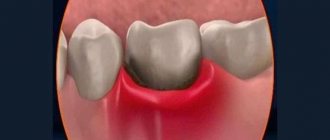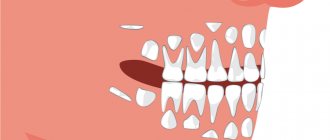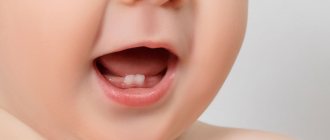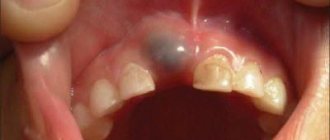The replacement of baby teeth with permanent ones usually takes place without any problems. However, many parents worry that some processes may go wrong. Therefore, they regularly monitor the condition of the baby’s teeth. Some people wonder how to distinguish a baby tooth from a permanent one, especially when it comes to molars. Indeed, when a child is 9-10 years old, this can become a problem - the incisors have already come out and there are no problems with them, but there is confusion with the distant teeth. How to learn to distinguish between them - let's figure it out together.
Anatomy of permanent teeth
The molar tooth includes three zones: the root, which sits deep in the jaw socket and holds the tooth in place, the neck, located in the periodontal area, and the crown, which extends directly into the oral cavity. After the apex of the tooth appears, a protective film forms on the enamel, the strongest layer of the tooth, which is soon replaced by a salivary layer, formed from the saliva itself. The dental tissues themselves are not just a piece of bone, but a certain heterogeneity, which includes, in addition to enamel, dentin (the main substance of the tooth) and the dental cavity, in which nerves and blood vessels branch. Compared to bones, for example, the phalanges of the fingers, dentin is noticeably stronger - it contains an increased amount of minerals, for example, the same calcium-based compounds. The root zone of dentin is connected to the periodontium using a special layer - dental cement, which communicates with the tissues of the periodontium itself and supplies the dentin with nutrients.
Differences between baby teeth and permanent teeth
The structure of primary and permanent teeth is generally the same, but there are several noticeable differences. Which are better not to neglect:
Baby teeth have whiter enamel, while permanent teeth have a slight yellowish tint. Milk teeth are not as strong as permanent teeth due to the lower percentage of mineral substances. The pulp of baby teeth is wider and thicker, while dentin and enamel are, on the contrary, thinner. This explains the facilitated, spontaneous removal of a shelf tooth - there are often situations when schoolchildren in class independently loosen and remove milk teeth that have served their purpose. In permanent teeth, the length is significantly greater, dominating over their width and cross-sectional area. The root of a baby tooth is thinner and shorter - a person is able to pull out a baby tooth without the help of specialists. Meanwhile, the permanent “embryo” of a real tooth under the shelf one is already ready to grow quickly and be born. The latter is achieved due to the dental gap, which has expanded by the time the non-permanent tooth falls out.
Adults also have milk “long-livers”
Yes, this is indeed possible. Milk teeth, which have a different structure and difference from permanent ones, may well be preserved in the bite of an adult. Whether to remove them, save them or replace them with prosthetics - this must be decided by the doctor depending on the clinical situation. For example, if they do not have the rudiments of permanent units under them, then you can simply improve the shape and aesthetics of the crown part so that they do not stand out in size against the background of their full-fledged “neighbors.” Read more about this phenomenon in the feature article on the website.
Where do teeth come from?
Teeth are formed in the fetus’s body during the mother’s pregnancy. When a mother abused something and undermined her own health, the subsequently born child was guaranteed to have diseased teeth that were no longer permanent. At the 15th week of pregnancy, the mother has hardened dental tissues in the fetus - starting from the crown area and ending with the root zone. The embryos of molar teeth are formed by the 5th month of fetal life. The body of a developing fetus and child is designed in such a way that in the upper jaw the anlage of the permanent teeth is located above the anlage of the milk teeth, and in the lower jaw - vice versa. The formation and development of teeth begins as early as the sixth week of fetal development. The source for them is a special epithelial dental plate. Already by 14 weeks of pregnancy, the unborn baby is actively forming hard dental tissues, initially in the area of the coronal part, and then in the area of the roots of the tooth. When a child is born, primary teeth are the first to grow - by the end of the child's first year of life, they will erupt. However, the dentition contains a group of large molars - they, in turn, do not have milk predecessors and subsequently, when they fall out, grow “on a permanent basis”. Nature has arranged it in such a way that while the child’s jaws are still too small, large molars are not needed there.
How many primary and molar teeth does a person have?
In children, the size of the jaw is almost half (in terms of the number of teeth that fit on it) smaller than in adults. Initially, the child has up to 20 teeth - 10 on each jaw. That is, one jaw - 4 incisors, 2 canines and 4 molars. Primary molars have not yet been clearly divided into small and large.
After 16 years, a teenager’s jaws reach approximate sizes that are accessible to an adult. A teenager already has approximately 28-30 teeth, and not 20-24, as before. The number of molars is often represented by 2 small molars and 2 large molars - on each side on each jaw. The last 2 or 4 teeth - “wisdom teeth” usually appear by the age of 20-22 - and a person acquires a full set of teeth, numbering 8 incisors, 4 canines, 8 small molars and 12 large molars - on both jaws in total.
Is there a difference?
It happens that, trying to determine which children have milk teeth, mothers make a significant wave of their hand and say that there are no differences between the new and old units. In fact, they are.
Dairy
They take their places for closer to two to three years. The very first ones erupt when the baby is 6-12 months old. There are only twenty primary teeth (while there are 32 primary teeth). Therefore, they are arranged in a row quite freely. As the jaw grows, the spaces between them increase significantly. This can be seen with the naked eye.
At the age of 5-6 years, temporary teeth begin to loosen and fall out. This process is completed by the age of 10-12 years.
Indigenous
They appear at five or six years old or a little later. First, molars grow , which become “sixes”. After this, the incisors begin to wobble. They are pushed out by a constant shift.
Children with permanent dentition usually have 28 teeth. The four terminal units (which are popularly called “wise”) usually appear after 20 years. For many, it grows at 30-40 years old. And this is the norm.
What does the dental formula look like?
The medical record, which the big one keeps in the dental clinic at his place of residence, contains notes about his dental condition. To avoid confusion, doctors number the teeth on each side of each jaw. So, the 1st and 2nd teeth are incisors, the 3rd are canines, the 4th and 5th are small molars (doctors call molars molars), the 6th and 7th are large molars. The 8th - the farthest one - is a “wisdom tooth”; a number of people do not have it, or they do, but not all. Each side of the jaw is also numbered: 1 - top right, 2 - top left, 3 - bottom left, 4 - bottom right. For example, entry 48 does not mean that you are a “Tarkatan” with a combat superset of teeth that does not exist. You simply do not have a “wisdom tooth” on the lower right. Entry 41 - a person lost one of the frontal incisors on the same side on the same jaw. You can write down the formula of the teeth more clearly: for example, “there is no 8th tooth from the bottom right.”
It often turns out that due to lack of space on the jaw, the wisdom tooth develops incorrectly - it can grow crooked, in which case its removal is indicated. For example, it may remain under the gum and, because of this, be affected by caries, which can subsequently develop into pulpitis or a dental cyst. Problematic “wisdom teeth” are quickly and decisively removed, and their absence will not greatly affect the quality of chewing food.
When does radiography come to the rescue?
Very rarely, but still situations occur in dental practice when even the doctor doubts which tooth he has to work with - a child’s or a molar. In this case, the capabilities of radiography are used. In the photographs you can see:
- length and structural features of the roots;
- presence/absence of radical primordia;
- the location of the unerupted unit and the direction of growth of its incisal edge.
If you need to find out exactly what the situation is with a change in bite in a child, contact your dentist. He will tell you the number of units that should fall out in the near future, and tell you whether it is worth interfering with this process.
Teething order
The timing of the appearance of permanent teeth to replace lost milk teeth is generally the same for all children and adolescents. After the child turns 5 years old, the first large molars make themselves felt. Then the central incisors are replaced from below, then the same teeth from above, and the lateral incisors from below. At 8-9 years of age, the lateral incisors on top are replaced. From 9 to 12 years of age, all small molars are replaced. At 13, all fangs are replaced. After 14 years, second large molars appear on all sides, which were not there before. By the age of 20-22, “wisdom teeth” finally appear. There are cases when during the rest of their lives they never erupted.
Possible problems
Permanent teeth have just appeared, but this does not mean that there will not immediately be any problems associated with them. Parents should be aware of possible dental problems:
- lack of molars;
- pain in the molar area;
- crooked position of molars;
- molars fall out;
- injuries.
For any of these problems, it is important to contact a specialist in time to receive qualified help.
How to determine that a child will soon have molars?
According to some of the signs, interdental intervals initially increase. This happens due to the growth of the jaw bones - the teeth begin to not fit tightly together, as happens in adults. Then the temporary teeth gradually become loose - due to the gradual disappearance of the temporary root, which can no longer reliably hold such a tooth, and itself is gradually pushed out of the soft and semi-soft tissues on the jaw. The loss of a temporary tooth is a clear sign that the permanent tooth is already growing in full force, and the top of its crown will soon push apart the gum tissue. The appearance of a new tooth is also accompanied by slight redness and swelling. If a child or teenager has a fever, their health has worsened, and their gums hurt, go to the doctor immediately.
Can milk root remain in the gums?
If you carefully examine fallen children's teeth, you will not be able to see any semblance of roots. Some mothers unknowingly begin to panic - it seems to them that a significant part of the unit remains in the deep tissues of the gums.
There is no need to worry - this is how it should be. The absence of roots is the result of their gradual resorption. This process starts long before the day of loss. That is why during a natural change (when a tooth falls out without outside help), the child does not experience pain.
No molars
The molars, despite the specific timing specified above, may ultimately not hatch. For example, temporary teeth do not fall out for a long time, and permanent teeth do not grow for a long time after they fall out. At the first stage, the dentist will take an X-ray of the condition of the child or teenager’s jaws. The X-ray machine will clearly project what should grow in place of the supposed teeth, which teeth are ready to hatch, and whether they exist at all. But the problem will immediately become obvious, and the reason for it most likely lies in the physiology of the child, which has undergone some delay. If this is true, be patient: in the end, the teeth will not take long to arrive. But if the picture shows emptiness, you are faced with a complete absence of teeth, the reason for which is a violation of the intrauterine development of the fetus during the mother’s pregnancy. Only prosthetics will help here - artificial insertion of false teeth.
Is there always a change?
Not a single child's tooth should be preserved - they all fall out. Instead of each temporary one, a permanent one is cut through. But it also occurs in dental practice that the rudiment of the root unit is missing. This can be seen in the X-ray of the jaws.
In this case, the life of the baby tooth is extended to the maximum - after all, nothing will grow in its place. When an empty space appears in the dentition, the issue of prosthetics is discussed.
To eliminate partial congenital edentia, you can implant an implant or install a dental bridge. In the first case, there is no need to file adjacent teeth. The doctor, under local anesthesia, installs an artificial titanium root into the jaw tissue. When it takes root, it fixes the dental crown.
In the case of a bridge, it is necessary to depulpate and prepare the neighbors . This is not very healthy, since their service life after such manipulations is significantly reduced. Therefore, young patients who do not have separate molars are recommended by dentists to resort to implantation.
Molar tooth hurts
After the molar has emerged from the gums, the “young” tooth enamel is not fully saturated with all the necessary microelements. During this period, the tooth is especially vulnerable: it is strictly forbidden to subject it to overload. It is not for nothing that children are advised not to chew, for example, candy, large quantities of peanuts, or any solid foods. If you neglect this rule, children may immediately develop caries, and this is the path to problems with specific teeth. Caries gradually turns into pulpitis (damage to the internal cavity of the tooth) and periodontitis (damage to the ligaments surrounding the tooth). The child often experiences toothache and poor general health. Without turning to a professional doctor for help in time, parents can lead their child to various consequences - up to the complete loss of a diseased tooth. If a predisposition to the appearance of carious lesions has been identified, their prevention may involve closing the natural deep pockets surrounding the molars. This is done using high-quality composite materials. In this case, food debris will not accumulate in these places, destructive microflora will not develop, and the period of susceptibility to caries will pass when the teenager grows up.
Sweet paste
Proper care will help preserve your baby's delicate teeth. It should be started immediately after teething. At first, this is done even without toothpaste and brush. In the morning and evening, or better yet, after each feeding, be sure to wipe your teeth with special napkins for oral hygiene. They carefully remove food particles, plaque and protect teeth from caries. Over time, you can use finger tips with silicone bristles.
When should you buy a toothbrush for your baby? As soon as he can brush his teeth and rinse his mouth with water on his own. When choosing a toothbrush, keep in mind that it should not be too hard so as not to wear away young, weakly mineralized enamel, and the width of the bristles should be no less than two and no more than three of the child’s teeth.
An equally important issue is the choice of toothpaste. One pasta for the whole family is excluded! The composition of children's pastes differs significantly from the composition of adult pastes. So, in children's pastes, there are different proportions and dosages of fluoride and calcium, which are necessary and harmless for the baby. Today, special pastes are produced for the little ones, for example, with natural plant extracts or various fruit and berry flavors.
The child’s nutrition also plays an important role in preserving and strengthening teeth. His diet should always include dairy products containing calcium, mineral water and sea fish - the main sources of fluoride. But sweets should be excluded if possible. From childhood, accustom your baby to healthy treats, for example, cut carrots, apples, turnips into cubes, and replace sweets and chocolate with figs, raisins, dried apricots or dates.
Molars grow crooked
Molars are also subject to crooked growth. They can begin to actively grow before the temporary ones become loose and fall out. Encountering this natural obstacle in the process of their growth, they can grow crookedly than would be intended by nature - they are “led” to the side. If the growth of a molar is detected immediately after a temporary one, this defect leads to a curvature of the bite, which is why the child or teenager will need the help of an orthodontist. In this case, it is necessary to urgently remove the temporary tooth that is interfering with the growth of the permanent one. If time has not yet been lost, it may be possible in this way to remove the predisposition of the same tooth to acquired curvature. Despite the fact that a teenager, having realized the uselessness of a temporary tooth, can independently loosen it and remove it, doctors strongly advise refraining from such a step so that the child avoids, for example, sepsis.
Symptoms that indicate that the process has begun:
- Some children experience an increase in temperature (up to 38). In this case, you should not hesitate; it is better to seek advice from your doctor.
- Unpleasant sensations in the gums.
- The space between the teeth increases.
- The roots begin to dissolve (The roots of baby teeth are much shorter than those of permanent teeth. When the process reaches the neck, a tooth change occurs).
- Gums are bleeding.
Molars fall out
If molars suddenly begin to fall out suddenly, this is a sign that the child’s health is not in the best condition. Tooth loss is preceded by both systemic diseases (immune problems, impaired development of connective tissue) and local ones (caries, pulpitis, periodontal disease, etc.). Tooth from permanent dentition. When lost, it leaves behind a permanent problem. A radical solution could be a complete insertion of an artificial tooth - but... Before it is carried out, the child will have to use a removable and replaceable prosthesis before he grows up.
Doctor's advice when the process of changing teeth begins:
- After tooth loss, let your baby not eat for 3 hours, and you should also not drink very cold or hot drinks.
- Protect your child from sour, spicy and very sweet, astringent foods. All this has a negative impact on teeth.
- If your baby is bothered by discomfort or pain after a baby tooth falls out, then buy a special gel, but it is better to choose it on the recommendation of a dentist.
- Do not let your child touch the hole where a tooth has fallen out, as it may become infected.
- To soothe your mouth, make a decoction of chamomile.
Injuries
An accident or incident, such as a fight, can cause a tooth injury. And it doesn’t matter whether a small part has broken off, or the tooth has cracked, as they say, “to the point of bleeding” - the help of a doctor is definitely needed. In some cases, lost dental tissue is replenished. If a tooth is broken into pieces, it will most likely need to be completely removed and a prosthesis replaced every year. And the answer is simple - the dental tissues have not yet fully matured, the body is growing. And it is necessary to take full care of your teeth at such an early age. In case of extension, the operation is performed by introducing composite materials that replace enamel and dentin.











